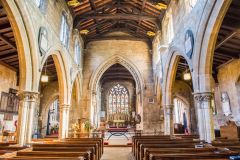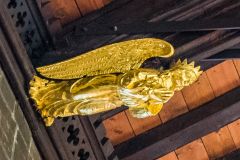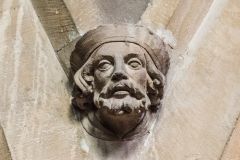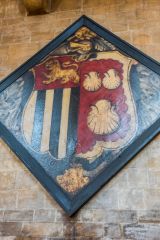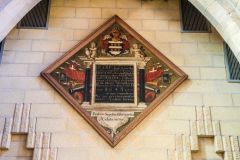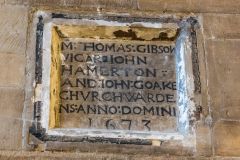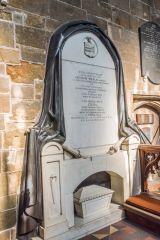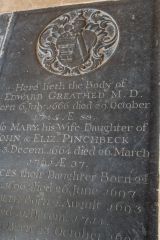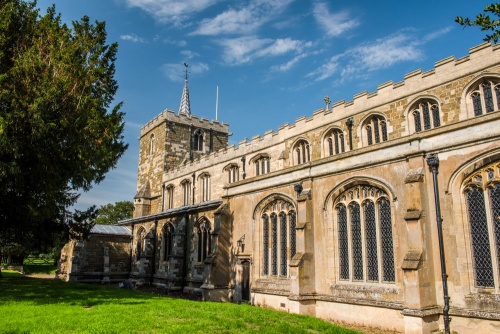
The oldest part of Horncastle's attractive parish church dates to the 13th century, but the history of St Mary's Church goes back long before then, back to the foundation of a Roman fort at the confluence of the river Waring and the river Bain.
There was almost certainly a Romano-British church on this spot. That early Roman building was rebuilt in the Saxon period when Horncastle's church was a minster, or mother church to outlying churches in the area.
History
Sometime in the early 13th century, the present church was built on the site of the Saxon minster. The medieval building lasted for over 500 years until it had to be restored in 1859 by Ewen Christian.
The church is built of Spilsby sandstone rubble, supporting a lead roof. There are a nave and chancel, each with a clerestory to admit more light, north and south aisles, north and south porches, and a squat west tower boasting an oddly proportioned spirelet.
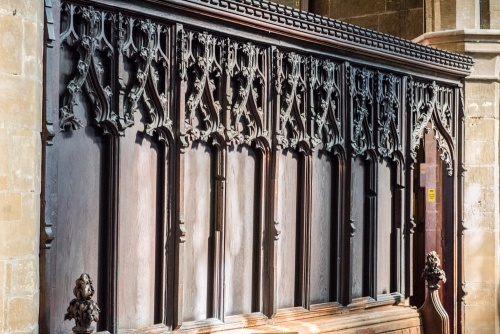
The church is a mix of styles representing restoration, expansion and rebuilding over the centuries. The lowest part of the building is in Early English style while the upper part of the walls is in Decorated Gothic. The remainder is a mixture of Perpendicular Gothic and Victorian Revival style.
The pillars of the nave arcade lean markedly to the south. According to tradition, this lean is intentional and reflects the leaning of Christ's head on the cross. The truth is more practical; the lean is a result of extra weight and architectural stress caused when the nave clerestory and timber roof were installed in the 15th century.
There are several extremely good memorials in the chancel. One of the most impressive is a large marble monument to Rev Clement Madeley (d. 1843). Nearby is another large monument to George Heald (d. 1834). Set into the chancel floor are three 18th-century grave slabs commemorating Thomas Lodinton, (d. 1723), John Shelly (d. 1707), and Jane Dymoke (d. 1745). In the south wall is a 14th-century piscina (heavily restored in the 19th century).
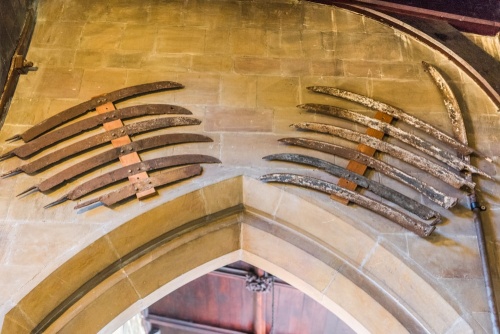
The chancel is separated from its north and south aisles by a pair of beautifully carved 14th-century wooden screens (restored in the 19th century).
In the south chapel is a monument to Rev Thomas Gibson, a staunch Royalist who was deprived of his living during the Civil War. Gibson lived to see the restoration of the monarchy and died in 1678. Nearby is a white marble monument to Thomas Friskney, died 1776.
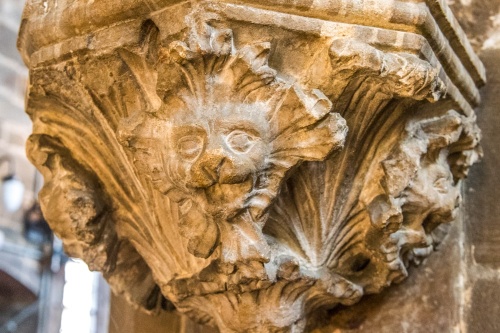
The King's Champion
In the nave is a small stone plaque inscribed 'Thos Gibson Vicar John Hamerton, John Goake Church Warden NS ANNO DOMINI 1673'. Also in the nave is a white marble monument to Elizabeth Kelham (d. 1780), but the most intriguing memorial is a brass commemorating Lionel Dymoke (d. 1519). The brass depicts Dymoke dressed in armour, kneeling, surrounded by his sons and daughters. In the floor of the north aisle is another Dymoke brass, to a different Lionel Dymoke.
The Dymokes held the post of King's Champion, a hereditary position giving them the right to ride fully armed to the coronation of a monarch and challenge anyone to contest the new monarch's right to the throne.
In the nave floor are several 18th-century graveslabs including those of William Hamerton (d. 1715) and Richard Everitt (d. 1783). On the wall are funeral hatchments commemorating Dr Thomas Sellwood (d. 1724) and Jane Dymoke (d. 1743). The oldest hatchment is a restored one commemorating Sir Ingram Hopton, who died at the Civil War battle of Winceby in 1643.
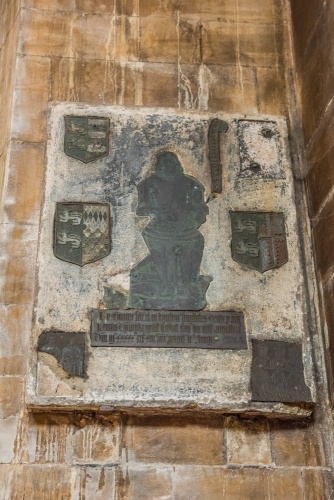
The Horncastle Scythes
Over the arch leading to the south chapel is the most peculiar historical treasure inside the church; a collection of 13 agricultural scythes. The scythes were used as weapons during the Lincolnshire Rising of 1536, an unsuccessful bid by local farmers to roll back the tide of the Dissolution of the Monasteries.
The farmers feared that St Mary's would be stripped of its furnishings. They coerced (or convinced) local gentry to support their cause and marched on Lincoln. The Rising faltered in the face of government troops, and the ringleaders were executed for treason.
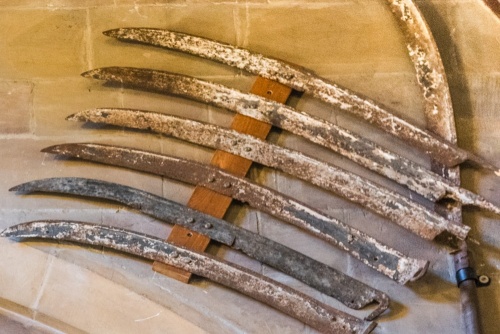
St Mary's is a wonderful medieval building, full of interest. It stands on the south-west corner of the market place in the centre of Horncastle. The church was open when we visited.
About Horncastle, St Mary's Church
Address: Church Lane,
Horncastle,
Lincolnshire,
England, LN9 5HW
Attraction Type: Historic Church
Location: In the south-west corner of the market place in the centre of Horncastle.
Website: Horncastle, St Mary's Church
Location
map
OS: TF258695
Photo Credit: David Ross and Britain Express
HERITAGE
 We've 'tagged' this attraction information to help you find related historic attractions and learn more about major time periods mentioned.
We've 'tagged' this attraction information to help you find related historic attractions and learn more about major time periods mentioned.
Find other attractions tagged with:
NEARBY HISTORIC ATTRACTIONS
Heritage Rated from 1- 5 (low to exceptional) on historic interest
Scrivelsby, St Benedict's Church - 2.4 miles (Historic Church) ![]()
Haltham-on-Bain, St Benedict's Church - 3.7 miles (Historic Church) ![]()
Petwood House Garden - 5.5 miles (Garden) ![]()
Revesby, St Lawrence Church - 5.6 miles (Historic Church) ![]()
Bolingbroke Castle - 6.3 miles (Castle) ![]()
Kirkstead Abbey - 6.4 miles (Abbey) ![]()
Kirkstead, St Leonard's Church - 6.6 miles (Historic Church) ![]()
Lincolnshire Aviation Heritage Centre - 6.7 miles (Museum) ![]()
Nearest Holiday Cottages to Horncastle, St Mary's Church:
Horncastle, Lincolnshire
Sleeps: 4
Stay from: £340 - 1423
More self catering near Horncastle, St Mary's Church
